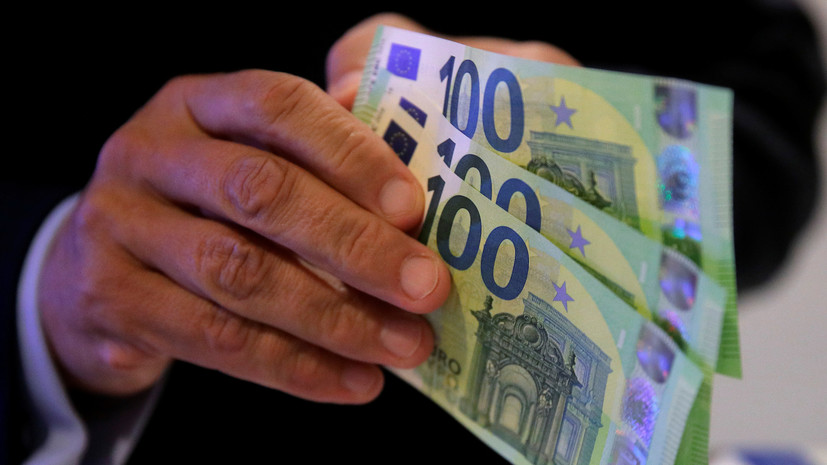Since the beginning of 2020, the euro has shown a record weakening in the global market. So, over the past seven weeks, the single European currency against the US dollar has fallen by 3.5% and reached $ 1,082 per euro at the February 18 auction. The last time a similar level could be observed in April 2017.
Investors react negatively to statistical data on the state of the eurozone economy. In the fourth quarter of 2019, the GDP of the union countries grew by only 0.9% compared to the same period in 2018. The growth rate was the weakest over the past four years. Such data are provided by Eurostat.
According to the materials of the department, throughout 2019, industrial production in the eurozone countries was continuously decreasing. At the same time, the current state of affairs in Germany and France, the leading economies of the region, is most worrying about the market players. So, in December, German industrial production collapsed immediately by 7.2%, and French - by 3.2%.
“First of all, the weakness of the European currency is caused by the continuing negative dynamics of Germany’s macroeconomic indicators - the flagship of the eurozone. From October to December 2019, German GDP showed almost zero growth. In fact, the country's economy is balancing on the brink of recession, ”Mikhail Zeltser, stock market expert at BCS Broker, said in an interview with RT.
It is noteworthy that in the near future the situation in the German economy may further deteriorate amid the spread of coronavirus in the PRC, Germany’s main trading partner. Thus, the expected fall in demand for German products from China risks increasing the industrial collapse in Germany. This point of view in a conversation with RT was expressed by the chief analyst of TeleTrade Mark Goichmann.
“Europe’s largest export-oriented economy, Germany, even more than the United States, depends on the supply of its products to China. Therefore, a sharp decline in demand for German goods from the PRC due to the virus is seriously affecting not only Germany, but also the eurozone as a whole, ”the expert said.
According to the head of the analytical department of AMarkets Artyom Deyev, a certain pressure on business activity in the production of Europe was exerted by the UK exit from the European Union.
“Brexit has become a rather severe blow to the EU economy, and the situation will be rectified for a rather long time. The fact is that London joined the European Community back in 1973, and during this time the parties managed to establish a large volume of trade and economic ties. The fact that the state has now left the European Union hit the rate of the single European currency, ”said Deev in an interview with RT.
Regulator pressure
As noted by Mikhail Zeltser, weak business activity in the eurozone forces the European Central Bank (ECB) to soften its monetary policy and lower its interest rate. The solution should support economic growth: loans will become cheaper, consumption and investment will begin to grow.
Recall that the leadership of the ECB began to soften monetary policy in 2008 against the backdrop of the global financial crisis. Moreover, since March 2016, the interest rate of the regulator has been at the level of 0% per annum.
According to experts, in the current economic conditions, the monetary authorities of the eurozone may further reduce the rate to negative values. As expected, the measure will support regional producers, but will make investments in European assets less profitable and further weaken the unified currency of the association.
“Long-term attempts by the ECB to stimulate the economy at low rates lead to the fact that investors are less likely to invest in European assets and more often prefer to take, for example, American ones. Thus, the yield on US dollar government securities with a maturity of 10 years is 1.6% per annum, while the yield on German government bonds in euros has already become negative and reached -0.4% per annum, ”said Mark Goichmann.
Moreover, in September 2019, in order to support the economy of the region, the ECB announced the launch of a quantitative easing program. The regulator turned on the printing press and began to buy government bonds of the eurozone countries with the money issued. Traditionally, such actions by the central bank lead to an increase in the money supply in the region, allow accelerating inflation and increasing GDP growth rates. However, over time, quantitative easing provokes an even greater reduction in the price of the euro.
Rate of decline
According to Mikhail Zeltser, the possible completion of a policy of low interest rates by the ECB could support the European currency. Meanwhile, the expert considers such a development of events unlikely in the near future.
According to the analyst, in the current conditions, the single European currency will continue to become cheaper in the world market in 2020 and the corresponding rate may drop to $ 1.06 per euro.
According to Artyom Deev, the dynamics of the euro can worsen as the situation with the coronavirus worsens. At the same time, the weakness of the European currency can positively affect the ruble exchange rate.
“In the foreseeable future, the downward trend in the European economy will continue, as long as the risks of the further spread of the disease remain and trade ties with Asian countries are limited. The exchange rate of the European currency against the Russian one is now in the range of 68.4–69 rubles per euro, but if the threat of the virus intensifies, the euro may weaken to 67–68 rubles, ”concluded Deev.

